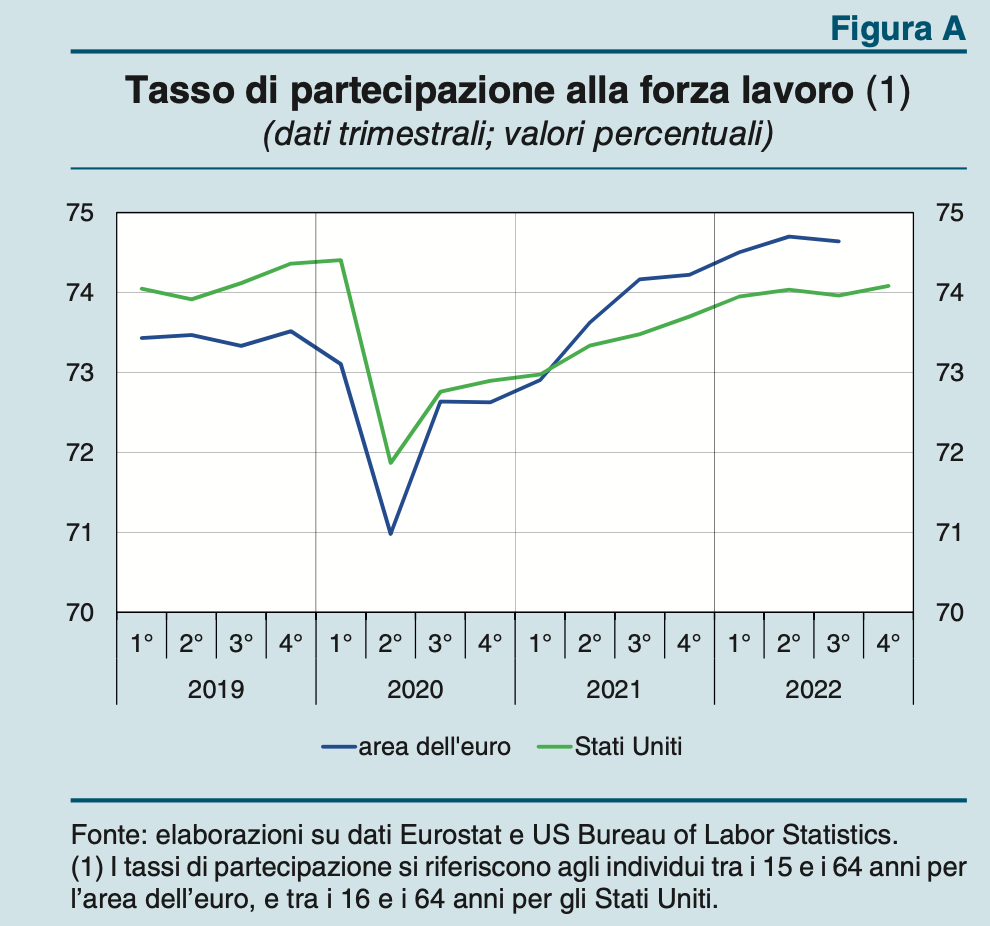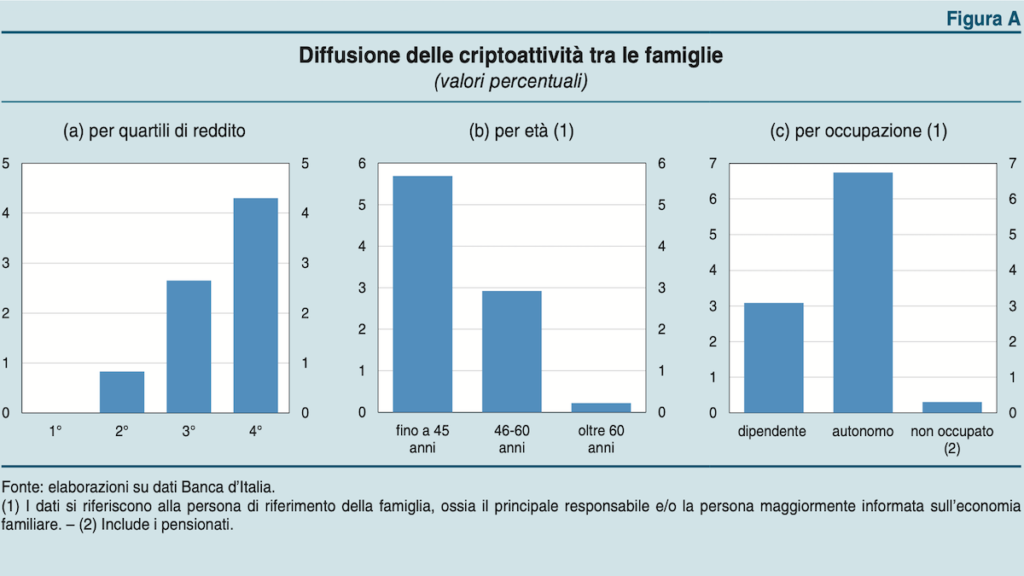THEItaly will not end in recession this year, if Russia does not completely cut energy supplies to Europe. 2022, on the other hand, is starting to close with a growth of 3,9% with a weakening in the fourth quarter compared to the third (+0,5% the latter), mainly due to the energy prices still high, the zero Covid policy in China, the weakness of household disposable income (with stable wages) and less favorable financial conditions. The numbers are contained in the Economic Bulletin of the Bank of Italy and concern the "baseline scenario", in which it is assumed that Russia will not cut energy supplies. And then there is the "adverse scenario", in which Moscow turns off the taps to Europe and in this case the GDP would decrease and theinflation it would still go up.
In the euro area, growth is slowing down, while inflation remains high
According to the most recent economic indicators, the Euro area GDP would have remained almost “stationary”. L'inflation consumption remained high (9,2% in December on an annual basis), although down from November; mainly due to past energy price hikes. The salary trend has slightly accentuated since October. The marked recovery in the participation rate and the stagnation of labor productivity - trends that differ from those observed in the USA - together with government measures to support families have helped to contain requests for wage increases.
The Bank of Italy has revised its growth estimates downwards for the current year, while those for inflation have been revised upwards for the two-year period 2023-24, "reflecting the more intense and persistent transmission of the pressures to consumer prices and the raising of wage growth estimates”.
Via Nazionale underlines that this is a "purely indicative projection" due to the high level of uncertainty, mainly due to developments in the war in Ukraine. And "in a scenario in which the permanent suspension of supplies of energy raw materials from Russia to Europe is assumed, the product would contract in 2023 and 2024 - he warns - and grow moderately in the following year". For inflation, Bank of Italy expects it to remain high, with a moderation at 6,5% in 2023 - the figure has been revised downwards compared to the estimate of 7,3% in the mid-December update - and then a slowdown "more marked later”, to 2,6% in 2024 and 2% in 2025.
In the fourth quarter, economic activity in Italy weakened
According to estimates by Via Nazionale, activity in Italy weakened in the last quarter of 2022. For two reasons: the attenuation of the recovery of the added value of services, which returned to pre-Covid values already in the summer months, both the decline in industrial production. Household spending seems to have slowed down, despite the measures to support disposable income in a context of high inflation. The companies interviewed as part of the Bank of Italy's surveys consider the conditions for investing to be still unfavourable.
the deficit of checking account it expanded, mainly due to the worsening energy deficit. But the net credit position abroad is still solid for Via Nazionale.
Employment grew slightly, while wage dynamics remain contained
The number of occupied it returned to increase slightly between October and November, still supported by the permanent component due to the transformation of temporary positions started in 2021. While the salary trend remains contained, also due to the continuation of the negotiation processes in services, where the share of employees waiting to renewal of the collective agreement. In 2023, wage dynamics would accelerate "moderately".
Labor market: comparison between the euro area and the USA
In the Economic Bulletin, Bank of Italy compares the labor market in the euro area with that of the United States. During 2022, the number of employed people in the euro area and in the USA exceeded pre-Covid levels, helping to bring the unemployment rate at historic lows. In the third quarter of 2022 it was 6,7% in the area, a value more than 3 points higher than that of the United States. "Significant differences in the trends of labor supply and demand and of the reallocation of employed persons determine wide divergences in the conditions of the labor market in the two economies".
After the sharp decline during the initial stages of the pandemic, in the euro area the participation rate of people aged between 15 and 64 has increased significantly and is currently at the highest values since the start of the survey. The good performance of the job offer was associated with the recovery of employment, back above pre-pandemic levels in all sectors except agriculture and services.

Despite the more rapid and marked recovery in economic activity, which normally drives the supply of labor, in the United States the participation rate has instead recorded a much more gradual and still incomplete recovery: in the fourth quarter of 2022 it was still 0,3, 16 percentage points below the pre-pandemic level in the 64-2019 age group. This evolution, given the intensification of demand, fuels difficulties in finding personnel for companies. The vacancy rate has reached very high values, particularly in sectors – such as leisure, accommodation and catering – where employment is still well below XNUMX levels. it is also reflected in the increase, attributable to changes in job positions, of the share relating to resignations out of the total number of terminations of employment relationships.
Salary growth more contained in the euro area than in the USA
Partly as a result of these trends, wage growth is much more contained in the area than in the United States. In the area, the increase in wages per hour worked was 3,1% in the third quarter compared to a year earlier. Public transfers to households in the face of energy price increases helped to contain workers' requests for wage increases. In the USA the salary trend is much more marked and stands at 5,2%, 3,1 points more than the average of the previous decade; the increase in wages is particularly high for workers who have changed jobs and in sectors where there are greater recruitment difficulties.
Bank of Italy: the increase in the cost of bank credit continues
Between August and November i bank loans to the non-financial private sector they slowed down, reflecting the weakening of both business demand for investment purposes and household demand for home purchases. The rate hike by the ECB it was passed on to the cost of bank credit, substantially in line with the average increase in the euro area. Also in Italy the conditions of the financial markets have improved overall since mid-October. The spread it stood at around 185 basis points in mid-January, well below the maximum values reached during the previous year.
Public finances improved in 2022
In 2022 there is also one deficit reduction and the ratio of public debt to GDP. In official assessments, compared to the framework under current legislation, the budget law approved by Parliament increases the deficit by 1,1 percentage points of GDP in 2023; the public debt as a ratio to GDP would continue to decrease, albeit at a slower pace. Last November, Italy received the second tranche of funds from the PNRR, amounting to 21 billion euros.
The possession of crypto-assets by Italian families
Finally, a look at the cryptoactivity. In recent years, household interest in these assets has grown globally, albeit in a heterogeneous way across countries. Over United States 12% of adults reported using or holding crypto assets in 2022; account for 4% of the euro area. The Bank of Italy conducted an experimental survey among 1.700 households between June and July 2022, in which it asked the household's contact person if at the end of 2021 anyone in their household possessed crypto-assets and, if so, to what amount .
Based on the data collected by Via Nazionale, 2,2% of Italian households held crypto assets. Similarly to what happens for traditional financial assets, the share of owners is higher among wealthy households: it goes from 4,3% of households in the highest quartile of income distribution to less than 1% of those in the second quartile . The diffusion of crypto is also greater among the most young (5,7% of families in which the respondent is under 45 years old, compared to 0,2% of the older group). The percentage is higher among freelancers and other self-employed workers (6,7%); it rises to 19% among the least risk averse subjects. As regards the amount: two thirds of households reported having up to 5.000 euros, while only 11% declared amounts exceeding 30.000 euros.






